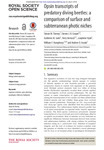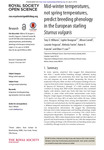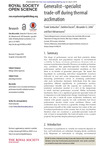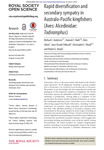Search
Now showing items 21-30 of 109
Prevalent endosymbiont zonation shapes the depth distributions of scleractinian coral species
(2015)
Bathymetric distributions of photosynthetic marine invertebrate species are relatively well studied, however the importance of symbiont zonation (i.e. hosting of distinct algal endosymbiont communities over depth) indetermining ...
Highly contrasted responses of Mediterranean octocorals to climate change along a depth gradient
(2015)
Climate change has a strong impact on marine ecosystems, including temperate species. Analysing the diversity of thermotolerance levels within species along with their genetic structure enables a better understanding of ...
Dramatic niche shifts and morphological change in two insular bird species
(2015)
Colonizations of islands are often associated with rapid morphological divergence. We present two previously unrecog-nized cases of dramatic morphological change and niche shifts in connection with colonization of tropical ...
New evidence on the tool assisted hunting exhibited by chimpanzees
(2015)
For anthropologists, meat eating by primates like chimpanzees (Pan troglodytes) warrants examination given the emphasis on hunting in human evolutionary history. As referential models, apes provide insight into the evolution ...
Opsin transcripts of predatory diving beetles
(2015)
The regressive evolution of eyes has long intrigued biologists yet the genetic underpinnings remain opaque. A system of discrete aquifers in arid Australia provides a powerful comparative means to explore trait regression ...
Mid winter temperatures, not spring temperatures, predict breeding phenology in the European starling Sturnus vulgaris
(2015)
In many species, empirical data suggest that temperatures less than 1 month before breeding strongly influence laying date, consistent with predictions that short lag times between cue and response are more reliable, ...
Generalist specialist trade off during thermal acclimation
(2015)
The shape of performance curves and their plasticity define how individuals and populations respond to environmental variability. In theory, maximum performance decreases with an increase in performance breadth. However, ...
Increased natural mortality at low abundance can generate an Allee effect in amarine fish
(2014)
Negative density dependent regulation of population dynamics promotes population growth at low abundance and is therefore vital for recovery following depletion. Inversely, any process that reduces the compensatory ...
Rapid diversification and secondary sympatry in Australo-Pacific kingfishers
(2015)
Todiramphus chlorisis the most widely distributed of the Pacific’s ‘great speciators’. Its 50 subspecies constitute a species complex that is distributed over 16 000km from the Red Sea to Polynesia. We present, to our ...
Competition and cooperationina synchronous bushcricket chorus
(The Royal Society, 2014)
Synchronous signalling within choruses of the same species either emerges from cooperation or competition. In our study on the katydid Mecopoda elongata, we aim to identify mechanisms driving evolution towards synchrony. ...










